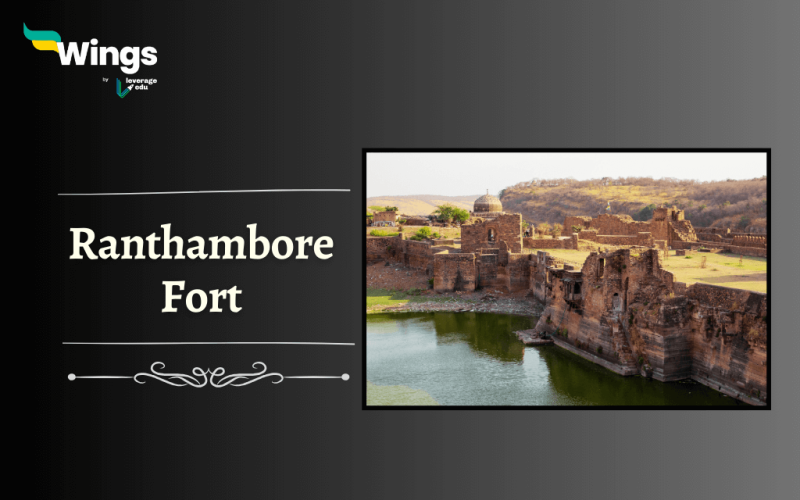Ranthambore Fort is situated right in the heart of the Ranthambore National Park in Sawai Madhopur city of Rajasthan, India. This magnificent fort has witnessed centuries of history, from the rule of Chauhans to the Mughals and its place in independent India. This formidable fort, which dates back to the 5th century, has witnessed the rise and fall of empires, battles fought and won, and rulers who have left their mark on its magnificent walls. Let’s delve into the Ranthambore fort history, features, facts and more information about the fort.
Table of Contents
| Commissioned by | Chauhan Ruler |
| Location | Sawai Madhopur, Rajasthan |
| Timings | 6:00 am to 6:00 pm; open everyday |
| Entry Fee for fort | ₹ 15 for Adults; ₹ 10 for Children |
| Camera | Both Still and Video Camera are allowed |
| Status | UNESCO World Heritage Site |
History of Ranthambore Fort
The fort is believed to have been built by the initial ruler of Rajasthan, King Sapaldaksha. Initially, the name of the fort was “Ranath Bhawar Garh”, which meant the place of the Rajput warriors.
- Ancient Origins: Built-in 944 AD by the Chauhan Rajput rulers, Ranthambore Fort was initially a humble hill fort. Over the centuries, it evolved into this stronghold. However, some believe the fort was built by King Jayanta in 1110 AD, which is still contested.
- Chauhan Dynasty: The fort served as a strategic centre for the rulers, allowing them to control trade routes and protect their kingdom. For a brief period of time, the fort also belonged to Muhammad Ghori in the year 1192, when Prithviraj Chauhan was defeated in the Second Battle of Tarain, but the Chauhans recaptured the fort.
- By the 15th century, many rulers like Illtutmish, Balban, Ala-ud-din Khilji, etc besieged the fort for a short time.
- Rajputs Rule: Ultimately, the fort went to Hada Rajputs of Bundi, during the reign of Rana Udai Singh I passing from the hand of Rana Hamir Sungh, Rana Kumbha and Rana Sanga from Mewar.
- Mughal Influence: In the 16th century, Ranthambore Fort fell into the hands of the Mughal Empire under Emperor Akbar. The fort underwent significant renovations and became a symbol of Mughal power in Rajasthan.
- Jaipur Rule: At the end of the 17th century, the Kachwaha Maharajas of Jaipur retained the fort themselves and became a hunting spot for the rulers. When India got its independence in 1947, the fort became part of Independent India.

Features of Ranthambore Fort
The formidable walls of the fort, towering over 700 feet above sea level, its impregnability and strategic significance are because of its features. Some of them are –
| Features | Description |
Architecture | Ranthambore Fort showcases a blend of Rajput and Mughal architectural styles, with intricately carved temples, palaces and gates. |
| The fort houses Bada Mahal, Hammir Court, Dhula Mahal and Phansi Ghar. Other attraction inside the fort includes Toran Dwar, Mahadeo Chhatri and Sametonki Haveli. | |
Temples | Within the fort complex, there are ancient temples dedicated to Hindu deities such as Ganesh, Shiva, and Ramlalaji. |
| The temple of Ganesh is one of the oldest temples in India and is built with Karauli stone. | |
Gates | One of the most famous entrances to Ranthambore Fort is Ganesh Pol, a grand gateway adorned with intricate carvings and sculptures. |
| Along with these, there are other elegant gates namely, Navlakha Pol, Hathi Pol, Andheri Pol, Sat Pol, Suraj Pol and Delhi Pol. | |
Water Management | Ranthambore Fort boasts a sophisticated water management system comprising tanks, reservoirs and step wells. This ingenious system ensured a stable water supply for the fort’s inhabitants during times of siege. |
Also Read – Neemrana Fort History: Features, Facts, Timings & More
Facts about Ranthambore Fort
- UNESCO World Heritage Site: Ranthambore Fort has been designated as a UNESCO World Heritage Site, under “Hill Forts of Rajasthan” in 2013.
- Tiger Reserve: The fort is located within the Ranthambore National Park, renowned for its population of Bengal tigers.
- Jauhar Site: The fort is also known for being a spot for Jauhar. It was during the war with Ala-ud-din Khilji that the royal ladies performed self-immolation in the year 1303.
Also Read- Naldurg Fort History: Features, Facts, Timings & More
Timings and Entry Fee of Ranthambore Fort
The timings for visiting the Monument and watching the mesmerising scene are –
| Purpose | Timings |
| Entry | 6:00 am to 6:00 pm |
| Week Entry | Everyday |
| Entry Fee | Adults – Rs 15 and Rs 10 for Children (changes applicable) |
In Conclusion, Ranthambore Fort is a majestic structure perched atop a hill and access to a beautiful sunset point. The fort holds within its walls centuries of history and war cries, though, in ruins now, it is a treasure trove of stories waiting to be told, simultaneously offering a glimpse into the glorious past of Rajasthan.
Other Attractions near Ranthambore Fort
| Ranthambore National Park | Ranthambore School of Art Society |
| Padam Talao | Jogi Mahal |
| Badal Mahal | Amreshwar Mahadev Temple |
Relevant Blogs
That’s all about Ranthambore Fort history! If you want to know more about topics like this, then visit our general knowledge page! Alternatively, you can also read our blog on general knowledge for competitive exams!
 One app for all your study abroad needs
One app for all your study abroad needs













